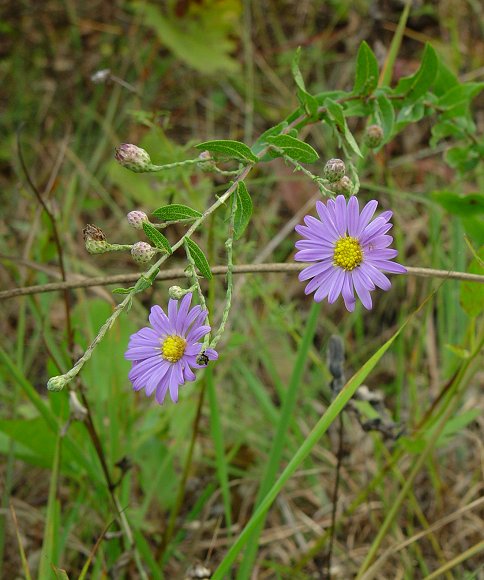Symphyotrichum patens (Aiton) G.L. Nesom
Spreading Aster

Native
CC = 5
CW = 5
MOC = 64
© DETenaglia
Symphyotrichum patens (Aiton) G.L. NesomSpreading Aster | |
 |
Native CC = 5 CW = 5 MOC = 64 |
© DETenaglia |
|
Family - Asteraceae/Astereae Habit - Perennial forb, usually from a short, stout, branched rootstock, this sometimes somewhat woody, occasionally also producing short rhizomes. Stems - Ascending to erect, to 1.2 m, with few to several ascending to spreading branches above the midpoint, evenly and moderately to densely pubescent (often somewhat roughened) with short, upward-curved hairs, these sometimes somewhat sparser toward the stem base.
Leaves - Alternate, simple, sessile, clasping, auriculate. Basal and lower stem leaves absent at flowering, sessile to short-petiolate, the blade 3-7 cm long, 1-3 cm wide, oblanceolate, tapered at the base, rounded or angled to a bluntly pointed tip, the margins entire or sparsely toothed, the margins and surfaces moderately roughened with short, stiff, curved hairs, the secondary veins on the leaf undersurface relatively easily observed, often irregularly fused toward their tips, the veinlets sometimes indistinct, forming a dense, irregular network of relatively short to somewhat elongate (usually wider than long) areoles. Median and upper stem leaves progressively smaller toward the stem tip, sessile, strongly clasping the stem, the blades 2-10 cm long, lanceolate to oblong-lanceolate, the largest leaves often narrowed toward the midpoint and broader toward the base and tip, the uppermost leaves often ovate, deeply cordate at the base, angled or tapered to a sharply pointed tip, the margins entire, otherwise similar to the lower stem leaves.
Inflorescence - Solitary terminal heads or small clusters at branch tips, sometimes appearing as open panicles. Heads appearing short- or long-stalked, the bracts 0.2-0.9 cm long, noticeably shorter than the adjacent foliage leaves, oblong-ovate to linear.
Heads - Radiate, mostly 2.0-3.5 cm in diameter at flowering. Involucre cylindric, 5-10 mm long, the bracts in 4-8 unequal, overlapping series. Involucral bracts linear to broadly lanceolate, angled or tapered at the pointed tip, the tip erect to somewhat outward-curved, the slender midvein broadened in the apical 1/5-1/2 into an elliptic or diamond-shaped, variable-length green tip, this also often purplish-tinged, the outer surface sparsely to densely pubescent with short, white, mostly appressed hairs and sometimes also with sessile and/or stalked, yellowish glands, the margins usually sparsely to moderately hairy toward the tip. Receptacle flat, naked.
Flowers - Ray florets 12-25 in usually 1 series, pistillate, the corollas well developed, 10-16 mm long, purple to bluish purple. Disk 5-9mm broad. Disc florets 20-50, perfect, the corollas 5-7 mm long, the slender portion of the tube shorter than the slightly expanded apical portion, the lobes 0.6-0.9 mm long, 18-22 percent of the total length of the expanded portion. Pappus of barbellate capillary bristles 4.5-7.0 mm long, off-white to cream-colored or tan.
Fruits - Achenes 2.5-3.5 mm long, with 7-10 longitudinal ribs, purplish brown to brown, moderately hairy. Flowering - August - October. Habitat - Glades, upland prairies, savannas, and forest openings, fields, fencerows, railroads, roadsides; often on acidic substrates. Origin - Native to the U.S. Lookalikes - Other species of Symphyotrichum. The leaves of this species are distinctive enough to allow identification even when flowers are not present. The closest lookalike is probably S. novae-angliae, but that species is much leafier and has more rays in the flowering heads, and is actually not very similar in overall appearance. Another lookalike, S. oblongifolium, also has many more cauline leaves below the branching of the inflorescence and more spreading hairs on its stems. Other info. - This attractive species occurs in Missouri south of a well-defined east-west boundary roughly coincident with the Missouri River. This boundary is the edge of the plant's natural range, which extends southward, eastward, and then northward, encompassing much of the U.S. southeastern quadrant and New England. The plant is one of the easiest asters to identify. Beyond having the characteristic purple ray flowers with yellow disks, the species has leaves which strongly clasp the stem, with distinctive rounded basal auricles. The stems are brittle and break easily. The flowers attract butterflies, and the plant is entirely appropriate for garden cultivation. It does well in rocky soils. Photographs taken in Umstead State Park, Raleigh, NC., 9-22-02, at Pilot Mountain State Park, NC., 10-20-02, and in Eminence, MO., 9-21-03 (DETenaglia); also at Little Lost Creek Conservation Area, Warren County, MO, 10-9-2020 (SRTurner). |